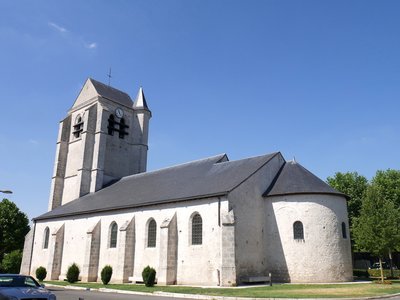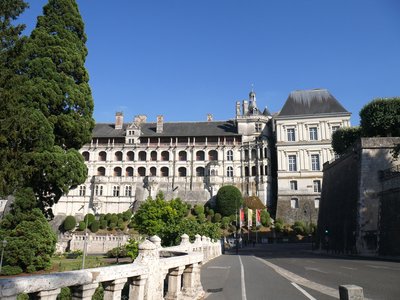De Mer to Blois

Centre-Val de Loire
5. De Mer to Blois
Medium
6h
23,4km
+177m
-167m
Step
Embed this item to access it offline
Leaving Mer you cross the Loire at Muides-sur-Loire to follow the left bank of the river. Let yourself be told the story of the monks Déodat and Baudemire who founded a 5th century hermitage on the site of the town of Saint-Dyé. Each house in this medieval pilgrimage town has a story to tell you. Take the road again in the direction of Montlivault with its church and the park of the castle. You will reach Blois, take a few hours to discover its historical heritage.
6 points of interest

Église Saint-Lubin à Muides-sur-Loire - Amis saint Colomban TouristSaint-Lubin Church in Muides-sur-Loire
Dedicated to Saint Lubin, Bishop of Chartres in the 6th century, the church originally depended on the provostry of Suèvres. In the 12th century, it entered the domain of Pontlevoy Abbey. In the 15th century, it is mentioned in the chapter of Saint-Martin-de-Tours. The present building is the result of restorations carried out in the 16th and 19th centuries. It consists of a nave and a choir with two bays ending in a three-sided apse. Two side chapels, of modern times, flank the choir. Warhead vaults dating from the end of the 19th century cover the entire building. The internal decoration was completely redone at the same period. Buttresses punctuate the outside walls. A polygonal, framed spire, above the entrance hall, crowns the two-sloped roof.
Église Saint-Dyé à Saint-Dyé-sur-Loire - Amis saint Colomban TouristSaint-Dyé church in Saint-Dyé-sur-Loire
The origin of the city is ancient; it takes its name from one of the two hermits Deodat and Beaumaire who, as early as the 5th century, worked to Christianize the surrounding populations. When Deodat died around 530, his disciples buried him in a pagan cave built as a crypt on which a first chapel was built. There were thus four successive buildings, the present church dating from the Renaissance. From then on, pilgrims flocked in and the village developed. At the end of the 15th century, on the occasion of a pilgrimage to Cléry, King Louis XI offered a precious hunt to shelter the relics of Saint Déodat (or Dyé). Exhibited for a few years, this hunt later disappeared, probably stolen. The Merovingian tomb of the saint that can be seen in the church ... is therefore quite empty!
Before leaving the church visit the dungeon where d'Artagnan was imprisoned.
A pilgrimage town, a fortified town, Saint-Dyé became a river trading port which became more important with the construction of Chambord, because it was there that most of the materials needed for the construction of the castle were unloaded.
A stroll through the town is recommended to discover the old houses and the museum of Autrefois.
If the church is closed, please contact the town hall.
Église Saint-Pierre de Montivault - Amis saint Colomban TouristSaint-Pierre Church in Montlivault
12th century church, with a 15th century bell tower that was once fortified. The south aisle was added in the 16th century. The rectangular nave ends with a choir and an apse reshaped into a hemicycle. The bell tower is made up of a square block and a polygonal turret. Each side of the second floor is pierced with geminated bays in tiers-point. A chapel of the Virgin was built in 1655 for the Charron family against the north wall. An extensive restoration programme carried out since 2000 has highlighted the interest of the church's frame, which is distinguished by its rather infrequent type. Traces of coloured plastering were found at the end of 2009 behind the pulpit on the north wall. A complete panel between two windows suggests that it was covered with historical scenes. The plaster is thought to be from the late Middle Ages.
Gabares sur la Loire à Blois - Amis saint Colomban PanoramicNavigation on the Loire: the Gabares
The term gabarre, gabare or gabarros (from the Greek karabos), actually designates several types of river boats from different basins of the Atlantic coast (Loire, Sèvre niortaise, Charente, Dordogne, Garonne). The only thing they have in common is that of all river transport boats: the flat bottom called "sole" which allows them to carry a maximum load with a shallow draught. Quite often, these boats can also be equipped with a rigging.
On the Loire and Charente rivers, this boat is built with "clins", i.e. the planks that make up the hull are superimposed on each other and pegged by pieces of wood.
Depending on the region, the freight consisted of ore and various agricultural products, wines (pediment, gaillac, cahors, wines from the Aveyron, Lot, Brulhois, wines from the haut pays...), building materials (Apremont stone on the Loire for example), metallurgical products (anchors and cannons from the Nivernais for example).
More information: Wikipedia
Vue générale de l’église Saint-Vincent de Paul, depuis le château de Blois - Amis saint Colomban TouristSaint-Vincent-de-Paul Church in Blois
In 1581, King Henri III ordered the construction of a chapel for the college he had just decided to create in Blois. In 1622, the Jesuits took charge of the establishment, at the request of the town's notables. It is thus finally in 1634 that the construction of a chapel begins on the plans of Estelle Martellange. However, the work drags on and it is only in 1655 that the exterior construction of the building is completed under the direction of Charles Turmel. From 1670, the chapel was transformed into a monument to the glory of the prince and his family.
In 1773, the Jesuits were expelled from France and therefore lost the direction of the Royal College and its chapel. During the Revolution, the establishment is disused.
Transformed into a fodder store shortly afterwards, the chapel only became a place of worship again in 1826, when it became Saint-Vincent-de-Paul church, before being renamed Notre-Dame de L'Immaculée Conception church in 1856. In the middle of the 19th century, the architect Jules de La Morandière undertook the restoration of the church. It was not completed until 1873.
According to Jesuit tradition, the church faces northwest, southeast.
Château royal de Blois - Amis saint Colomban HistoricalRoyal Castle of Blois
During the reign of Charles the Bald, in 854, the Blisum castrum ("the castle of Blois"), built on the banks of the Loire, was attacked by the Vikings. The rebuilt fortress is at the heart of the region, controlled by the Counts of Blois, powerful feudal lords in the 10th and 11th centuries.
In the 13th century, the castle is rebuilt by the Burgundian family of Châtillon. The chronicler Jean Froissard described it as "beautiful and large, strong and lush, one of the most beautiful in the kingdom of France". The last descendant of the family of Châtillon, Guy II of Blois-Châtillon, sold the house in 1392 to Louis d'Orléans, brother of Charles VI.
In 1429, before her departure to lift the siege of Orleans, Joan of Arc is blessed in the chapel of the castle of Blois by Regnault de Chartres, Archbishop-Duke of Reims.
On 27 June 1462, Louis d'Orléans, son of Charles I of Orléans, was born in the castle of Blois. He became King of France in 1498 under the name of Louis XII; the medieval castle of the Counts of Blois became the royal residence and Louis made it his main residence, to the detriment of the castle of Amboise. Louis XII undertakes, with Anne of Brittany (his wife since 1499), a reconstruction of the castle in what will be called thereafter the Louis XII style by combining the flamboyant Gothic style with elements already belonging to the Renaissance style. During the following centuries the crowned heads will occupy the castle and embellish it.
More info: Wikipedia
To visit the castle
Description
To the left of the church cross the Rue Nationale, Rue Barreau, take the cycle track and leave the town, cross the Loire.
- Muides-sur-Loire, on the right after the campsite, avenue de la Loire, chemin du Mene, at the fork in the road turn left onto an earth towpath.
- At the junction with the D 951, cross, take the path that runs along the departmental road and first path on the left and first path on the right.
- Crossroads D 84 in Montlivault, turn left towards the town centre, after the church, turn right, rue de l'Église, right, rue de la Justice, go around the castle park, left, rue de la Basse, first street on the right,
- Cross Ruisseau La Noue, on the left, a dirt road along the brook, turn right at a right angle, and on the left, following a brook diversion canal.
- Turn right at the crossroads with asphalt road to the bike path along the Loire on the left, stay on the bike path, pass under the motorway, go to the Jacques Gabriel bridge, cross the Loire river.
- Rue Denis Papin, second street on the right, rue du Poids du Roi, at the beginning of the rue des Papegaults take the staircase of the Degrees of Saint-Louis, you arrive at the Saint-Louis Cathedral.
- Departure : Saint-Hilaire Church, Place de la Mairie, 41500 Mer
- Arrival : Saint-Louis Cathedral, 7 Place Saint-Louis, 41000 Blois
- Towns crossed : Centre-Val de Loire
Altimetric profile
Transport
Report a problem or an error
If you have found an error on this page or if you have noticed any problems during your hike, please report them to us here:








